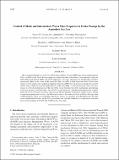Files in this item
Control of mode and intermediate water mass properties in Drake Passage by the Amundsen Sea low
Item metadata
| dc.contributor.author | Close, Sally | |
| dc.contributor.author | Naveira Garabato, Alberto | |
| dc.contributor.author | McDonagh, Elaine | |
| dc.contributor.author | King, Brian | |
| dc.contributor.author | Biuw, Martin | |
| dc.contributor.author | Boehme, Lars | |
| dc.date.accessioned | 2014-01-15T00:02:23Z | |
| dc.date.available | 2014-01-15T00:02:23Z | |
| dc.date.issued | 2013-07 | |
| dc.identifier | 21234532 | |
| dc.identifier | 8284f1ad-7b07-4aaf-8c6a-6af0147d165c | |
| dc.identifier | 84880680909 | |
| dc.identifier.citation | Close , S , Naveira Garabato , A , McDonagh , E , King , B , Biuw , M & Boehme , L 2013 , ' Control of mode and intermediate water mass properties in Drake Passage by the Amundsen Sea low ' , Journal of Climate , vol. 26 , no. 14 , JCLI-D-12-00346 , pp. 5102-5123 . https://doi.org/10.1175/JCLI-D-12-00346.1 | en |
| dc.identifier.issn | 0894-8755 | |
| dc.identifier.uri | https://hdl.handle.net/10023/4370 | |
| dc.description.abstract | The evolution of the physical properties of Subantarctic Mode Water (SAMW) and Antarctic Intermediate Water (AAIW) in the Drake Passage region are examined on time scales down to intraseasonal, within the 1969 - 2009 period. Both SAMW and AAIW experience substantial interannual to interdecadal variability, significantly linked to the action of the Amundsen Sea Low (ASL) in their formation areas. Observations suggest that the interdecadal freshening tendency evident in SAMW over the past three decades has recently abated, whilst AAIW has warmed significantly since the early 2000s. The two water masses have also experienced a substantial lightening since the start of the record. Examination of the mechanisms underpinning water mass property variability shows that SAMW characteristics are controlled predominantly by a combination of air-sea turbulent heat fluxes, cross-frontal Ekman transport of Antarctic surface waters and the evaporation-precipitation balance, whilst AAIW properties reflect air-sea turbulent heat fluxes and sea ice formation in the Bellingshausen Sea. The recent interdecadal evolution of the ASL is consistent with both the dominance of the processes described here and the response of SAMW and AAIW on that time scale. | |
| dc.format.extent | 22 | |
| dc.format.extent | 2729487 | |
| dc.language.iso | eng | |
| dc.relation.ispartof | Journal of Climate | en |
| dc.subject | Atmosphere-ocean interaction | en |
| dc.subject | Water masses | en |
| dc.subject | Interannual variability | en |
| dc.subject | GC Oceanography | en |
| dc.subject.lcc | GC | en |
| dc.title | Control of mode and intermediate water mass properties in Drake Passage by the Amundsen Sea low | en |
| dc.type | Journal article | en |
| dc.contributor.sponsor | NERC | en |
| dc.contributor.sponsor | NERC | en |
| dc.contributor.institution | University of St Andrews. School of Biology | en |
| dc.contributor.institution | University of St Andrews. Scottish Oceans Institute | en |
| dc.contributor.institution | University of St Andrews. Marine Alliance for Science & Technology Scotland | en |
| dc.contributor.institution | University of St Andrews. Sea Mammal Research Unit | en |
| dc.identifier.doi | https://doi.org/10.1175/JCLI-D-12-00346.1 | |
| dc.description.status | Peer reviewed | en |
| dc.date.embargoedUntil | 2014-01-15 | |
| dc.identifier.url | http://journals.ametsoc.org/doi/abs/10.1175/JCLI-D-12-00346.1 | en |
| dc.identifier.grantnumber | NE/E018289/1 | en |
| dc.identifier.grantnumber | en |
This item appears in the following Collection(s)
Items in the St Andrews Research Repository are protected by copyright, with all rights reserved, unless otherwise indicated.

